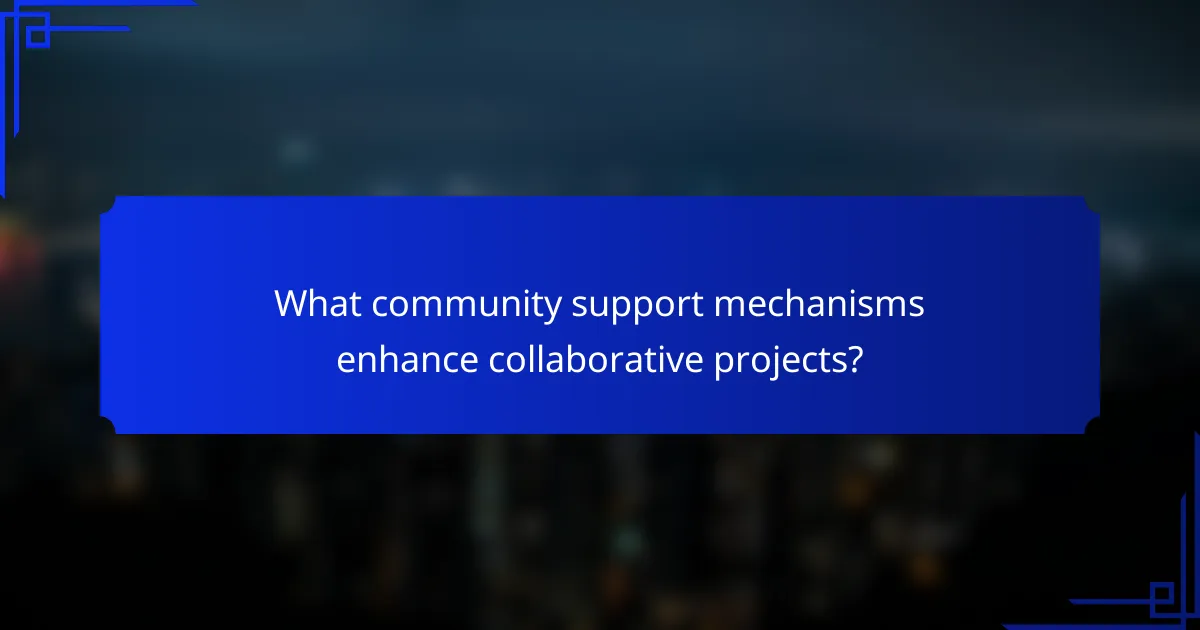Collaborative projects serve as a powerful catalyst for entrepreneurial advocacy and community support, particularly in urban settings. By uniting entrepreneurs, community organizations, and government entities, these initiatives create a robust ecosystem that fosters economic development and innovation. Through shared resources and networking opportunities, they empower local businesses to thrive and achieve common goals.

How can collaborative projects drive entrepreneurial advocacy in urban areas?
Collaborative projects can significantly enhance entrepreneurial advocacy in urban areas by fostering a supportive ecosystem that empowers local businesses. These initiatives often bring together various stakeholders, including entrepreneurs, community organizations, and government entities, to create a shared vision for economic development.
Community engagement initiatives
Community engagement initiatives are vital for building trust and collaboration among local entrepreneurs and residents. These projects can include workshops, town hall meetings, and collaborative events that encourage participation and feedback from the community. By involving residents in the entrepreneurial process, businesses can better align their offerings with local needs.
Examples of successful community engagement initiatives include local markets that showcase small businesses or community forums that discuss economic challenges and opportunities. These platforms not only promote local products but also strengthen community ties, making it easier for entrepreneurs to thrive.
Mentorship programs for startups
Mentorship programs are essential for nurturing startups by connecting new entrepreneurs with experienced business leaders. These programs can provide guidance on various aspects of running a business, including marketing strategies, financial management, and operational efficiency. A well-structured mentorship program can significantly increase a startup’s chances of success.
In urban areas, mentorship programs can be tailored to address specific challenges, such as navigating local regulations or accessing funding sources. For instance, pairing startups with mentors who have successfully launched businesses in similar environments can offer invaluable insights and practical advice.
Networking events for entrepreneurs
Networking events play a crucial role in fostering connections among entrepreneurs, investors, and industry experts. These gatherings provide opportunities for business owners to share ideas, seek advice, and form partnerships that can lead to collaborative projects. Regularly scheduled networking events can help build a vibrant entrepreneurial community.
Effective networking events often include panel discussions, pitch competitions, and informal meet-and-greet sessions. Entrepreneurs should aim to attend these events to expand their professional networks and explore potential collaborations that can enhance their business initiatives.

What community support mechanisms enhance collaborative projects?
Community support mechanisms play a crucial role in enhancing collaborative projects by providing resources, networking opportunities, and shared knowledge. These mechanisms can include local business incubators, nonprofit partnerships, and various funding opportunities that facilitate joint initiatives.
Local business incubators
Local business incubators are organizations designed to support startups and small businesses through mentorship, resources, and networking. They often provide shared office spaces, access to business development programs, and connections to potential investors.
Participating in an incubator can significantly boost a collaborative project by offering a structured environment for growth and innovation. Entrepreneurs should research incubators in their area, as many focus on specific industries or demographics, enhancing the relevance of support received.
Nonprofit partnerships for resource sharing
Nonprofit partnerships can be instrumental in resource sharing for collaborative projects. By teaming up with nonprofits, businesses can leverage existing networks, expertise, and resources that may not be available otherwise.
These partnerships often lead to joint initiatives that address community needs while providing mutual benefits. For example, a tech startup might partner with a nonprofit focused on education to develop programs that enhance digital literacy, combining their strengths for greater impact.
Grants and funding opportunities
Grants and funding opportunities are essential for financing collaborative projects. Various government agencies, foundations, and private organizations offer grants specifically aimed at supporting joint initiatives that benefit communities.
Entrepreneurs should actively seek out these funding sources, as they can cover a range of expenses from project development to marketing. It’s advisable to carefully read grant requirements and tailor applications to align with the funder’s mission, increasing the chances of securing financial support.

What are effective joint initiatives for entrepreneurs?
Effective joint initiatives for entrepreneurs include collaborative efforts that leverage shared resources, skills, and networks to achieve common goals. These initiatives can enhance visibility, reduce costs, and foster innovation among participating businesses.
Co-working spaces for collaboration
Co-working spaces provide an environment where entrepreneurs can work alongside one another, facilitating collaboration and networking. These shared offices often host events, workshops, and networking sessions that encourage interaction and idea exchange.
When selecting a co-working space, consider factors such as location, amenities, and community culture. Many spaces offer flexible membership plans, allowing entrepreneurs to choose options that fit their budget and needs.
Joint marketing campaigns
Joint marketing campaigns involve multiple businesses collaborating to promote their products or services together. This approach can amplify reach and reduce marketing costs, as partners share resources and audiences.
To execute a successful joint marketing campaign, identify complementary businesses with aligned target markets. Develop a clear strategy that outlines shared goals, messaging, and promotional channels, such as social media, email, or events.
Shared technology platforms
Shared technology platforms enable entrepreneurs to access tools and resources that might be too costly or complex to develop independently. These platforms can include software for project management, customer relationship management, or e-commerce.
When considering shared technology solutions, evaluate the scalability, user-friendliness, and support offered by the platform. Collaborating on technology can lead to improved efficiency and innovation, as businesses can share insights and best practices.

What criteria should be considered when forming collaborative projects?
When forming collaborative projects, it is essential to consider alignment of goals and values, as well as resource availability and contribution. These criteria help ensure that all parties are committed and can effectively support the initiative.
Alignment of goals and values
Alignment of goals and values is crucial for the success of collaborative projects. All partners should share a common vision and objectives to foster a cohesive working environment. For instance, if one organization prioritizes sustainability while another focuses on profit maximization, conflicts may arise.
To assess alignment, partners can conduct workshops or discussions to clarify their missions and objectives. A simple checklist can help identify shared values, such as community impact, innovation, or social responsibility. This process can prevent misunderstandings and ensure all parties are on the same page.
Resource availability and contribution
Resource availability and contribution are vital factors in collaborative projects. Each partner must evaluate what resources they can bring to the table, including financial support, expertise, or manpower. For example, a small nonprofit may offer volunteer hours, while a larger corporation might provide funding.
It is important to establish clear expectations regarding contributions early in the collaboration. A written agreement detailing each partner’s resources can help avoid disputes later. Additionally, regularly reviewing resource allocation can ensure that all parties remain engaged and committed throughout the project.

How can entrepreneurs measure the success of collaborative initiatives?
Entrepreneurs can measure the success of collaborative initiatives through various metrics that reflect both qualitative and quantitative outcomes. Key indicators include performance metrics, stakeholder feedback, and financial assessments, which together provide a comprehensive view of the initiative’s impact.
Key performance indicators (KPIs)
Key performance indicators (KPIs) are essential for evaluating the effectiveness of collaborative initiatives. Common KPIs include project completion rates, participant engagement levels, and the achievement of specific project milestones. Entrepreneurs should select KPIs that align with their goals and regularly track them to gauge progress.
For instance, if a collaborative project aims to increase community engagement, measuring the number of participants and their active involvement can provide insight into success. Setting benchmarks for these KPIs can help in assessing whether the initiative meets its objectives.
Feedback from community stakeholders
Gathering feedback from community stakeholders is crucial for understanding the broader impact of collaborative initiatives. Surveys, interviews, and focus groups can be effective methods for collecting insights on stakeholder satisfaction and perceived value. This qualitative data can highlight areas of success and opportunities for improvement.
Entrepreneurs should aim to engage stakeholders regularly, ensuring that their voices are heard throughout the project lifecycle. This ongoing dialogue not only fosters trust but also helps refine the initiative based on real community needs and expectations.
Financial impact assessments
Financial impact assessments provide a clear picture of the economic benefits generated by collaborative initiatives. Entrepreneurs should analyze both direct and indirect financial outcomes, such as revenue growth, cost savings, and potential job creation. This assessment can help in determining the overall return on investment (ROI) of the initiative.
For example, if a joint initiative leads to increased sales for local businesses, quantifying this increase can illustrate the project’s financial success. Regular financial reviews can help entrepreneurs adjust strategies and ensure that the initiative remains sustainable and beneficial for all parties involved.

What emerging trends are shaping collaborative projects in entrepreneurship?
Emerging trends in collaborative projects for entrepreneurship include the integration of digital tools, a heightened focus on sustainability, and the rise of remote initiatives. These trends are reshaping how entrepreneurs engage with communities and support joint ventures.
Increased use of digital collaboration tools
The adoption of digital collaboration tools has transformed how entrepreneurs work together. Platforms like Slack, Trello, and Zoom facilitate real-time communication and project management, allowing teams to coordinate more effectively regardless of their physical location.
When selecting digital tools, consider factors such as user-friendliness, integration capabilities, and cost. Many tools offer free versions or tiered pricing, making it easier for startups to find solutions that fit their budget.
Focus on sustainability and social impact
Today’s collaborative projects increasingly prioritize sustainability and social impact. Entrepreneurs are more likely to engage in initiatives that not only drive profit but also contribute positively to society and the environment.
To align with this trend, consider incorporating sustainable practices into your projects, such as using eco-friendly materials or supporting local communities. This approach can enhance your brand’s reputation and attract customers who value corporate responsibility.
Growth of remote collaborative initiatives
The growth of remote collaborative initiatives has been accelerated by advancements in technology and changing work preferences. Entrepreneurs are now able to form partnerships and collaborate with individuals from diverse geographical locations, expanding their networks and resources.
When engaging in remote collaborations, establish clear communication protocols and set expectations early on. Tools like video conferencing and shared documents can help maintain transparency and accountability among team members, ensuring that everyone stays aligned on project goals.
